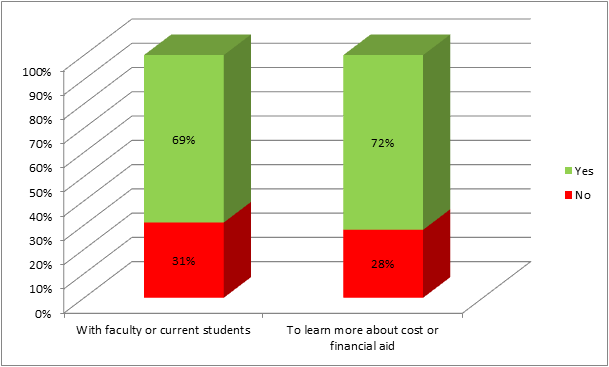enrollment
Three ways to facilitate more live conversations with prospective college students
As I present the findings from the latest E-Expectations research with clients and colleagues, one of the areas that generates the most discussion is the apparent interest prospective students show in using Webcams and other tools to have live conversations with current students, faculty, and admissions representatives.
Would prospective college students participate in live chats?

People asking about these live chats typically want to know how to operationalize this opportunity. Here are some ideas for piloting your first steps in using a Webcam to facilitate conversations with prospects.
1. Start small
Some of our clients report that they’re already using Skype to facilitate one-on-one conversations between counselors and prospective students. If your team hasn’t tried any live conversations using a Web camera yet, this can be a great place to start.
If you don’t have much experience with these kinds of engagements or tools, start small with a focused pilot. You may find some of your team are already using Webcams in their one-on-one conversations with family and friends. They’re likely to be most comfortable adapting this approach to their student engagements.
After identifying one or two counselors who have some personal experience with a Web cam, ask them to integrate it into their contact schedule. Remember that how you appear will make an impression along with what you say, so have counselors first practice with colleagues or current students to plan their conversations as well as ensure that the lighting and décor of their office spaces are appropriate.
These connections could be facilitated in an ad hoc manner—a counselor engaged in a text exchange with a student could suggest they move to Webcam, for instance. Or counselors could send individual e-mail messages to students on their list to make appointments to connect.
2. Try a small group conversation next
Tools like Google+, Skype, and GoToMeeting allow users to connect small groups of individuals using Web cameras on their desktops or mobile devices. This might be an interesting approach if you wanted to connect students interested in a particular program with current students representing that discipline.
A little scripting in advance is a good strategy to ensure that each one of your campus participants has an opportunity to share their views or experiences without talking over each other.
These small group sessions could be facilitated in the manner suggested for the one-on-one sessions, or perhaps through a short registration form as part of a landing page on the Web site or in an e-mail campaign. Also, the definition of “small” groups may vary by campus and counselor. What you want to do is make sure that the groups are small enough that the campus representative can make strong individual connections with each participant in addition to addressing the entire group.
3. Go big
Webcasts or Web conferences offer a nice step up from the text-based live chat events that schools have been offering for years. One keynote speaker or a panel of speakers can be used to convey key positioning themes and process information.
While larger forums may prohibit participants from asking questions in an ad hoc, conversational manner, participants can type questions that presenters can read aloud and answer through the course of the event or in a one-on-one communication afterward.
Another benefit to these kinds of engagement opportunities is that they provide a helpful call-to-action for your e-mail communication flows and social media posts. Add the invitations to your Webcast events or suggest that the individual schedule a Webcam meeting with their counselor within your upcoming e-mail messages and through your social media communications.
Decide ahead of time how you’ll measure the results of your efforts. For a one-on-one conversation or small-group discussion, you might measure the length of time of the conversation and whether the participants took the next step in their enrollment process. For a larger group event, compare the number of students invited to the number who actually attended. The average length of time participants stayed connected to the event and the number of questions asked are also helpful data points to collect and consider.
I’ve hinted at some integration of live conversations with e-mail and social media campaigns, but if you want to discuss these strategies further, please drop me an e-mail. And watch for additional posts that will expand on these ideas and add further dimension to our E-Expectations results.